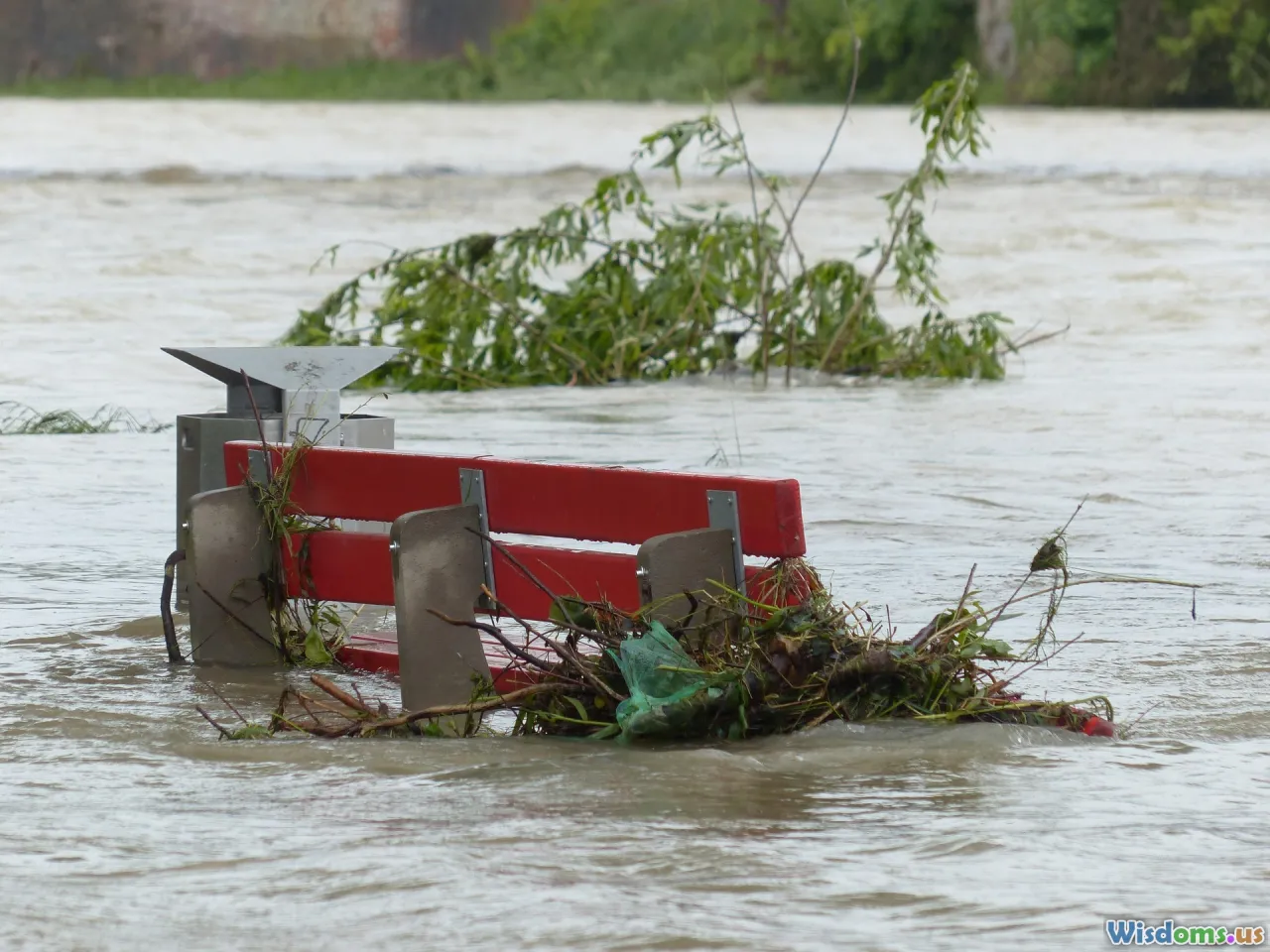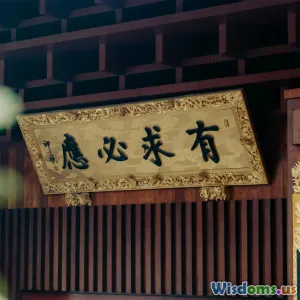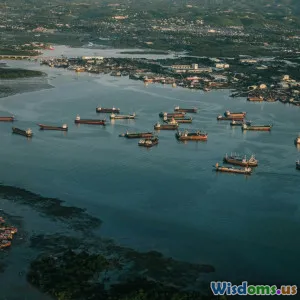
Unearthing Yellow River Floods Impact on Civilization
15 min read Discover how Yellow River floods shaped Chinese civilization—uncovering dramatic impacts on society, innovation, politics, and environmental change across millennia. (0 Reviews)
Unearthing Yellow River Floods’ Impact on Civilization
Introduction: The Wrath and Blessing of the “Mother River”
For over five millennia, the Yellow River—Huang He in Chinese—has been far more than a geographical landmark. Termed "China’s Sorrow" and the “Mother River”, it has assisted Chinese civilization’s very rise—only to threaten it repeatedly with catastrophic floods. These drastic deluges routinely re-shaped not only the surrounding landscape but profoundly influenced human society, government, technological innovation, and even spiritual beliefs.
Why did the Yellow River’s cycles of devastation paradoxically nourish China’s greatness? How did countless generations battle, adapt to, and—at times—embrace the river’s unpredictability? From ancient Neolithic villages washed away in the blink of an eye to modern feats of hydraulic engineering, the annals of the Yellow River serve as a cautionary tale, a source of inspiration, and a blueprint for resilience itself.
In this article, delve deep into the multifaceted impact of one river’s tempests. Discover stories of disaster and innovation, cultural transformation, and enduring lessons for today’s world.
Understanding the Yellow River’s Fury: A Geographical and Environmental Primer
The River’s Unusual Nature
Stretching over 5,400 kilometers from the Tibetan Plateau to the Bohai Sea, the Yellow River is notorious for its thick load of silt—the highest among all the world’s major rivers. This silt comes from the Loess Plateau, whose soft soil is devastatingly vulnerable to erosion. The result: the river frequently changes course, raises its bed higher than surrounding plains, and floods unpredictably.
Anatomy of Floods
Lands near the lower reaches of the Yellow River are especially prone to disaster. As early as 2294 BCE, ancient chronicles report catastrophic floods. By the Ming and Qing dynasties, flooding was not an “if” but a “when.” Major floods could push water up to 150 kilometers from the riverbank, inundating entire provinces, rendering millions homeless—sometimes even redirecting the river by hundreds of kilometers overnight.
Examples that Shocked China:
- 1332-1333 CE: During the Yuan dynasty, floods are estimated to have killed 7 million people, among the deadliest natural disasters in recorded history.
- 1887 CE: Perhaps the worst, this flood breached dikes, devastated with waters spreading across 130,000 km², affecting 2 million lives.
- 1938 CE: In a desperate wartime move, Chinese Nationalist forces deliberately breached dikes to slow the invading Japanese army, causing a deluge that resulted in the death of possibly 500,000-800,000 civilians.
Cradle of Civilization—or Catastrophic Destroyer?
Fertility and the Imprint of Disaster
Despite their devastation, Yellow River floods also proved critical to the birth and persistence of ancient Chinese civilizations. Silt-laden floodwaters enrich fields, supporting agriculture in otherwise marginal lands—a reason why Neolithic settlements and early dynasties, such as Xia and Shang, flourished here.
Archaeological studies at sites like Banpo near Xi’an reveal how communities adapted time and again to changing river paths. According to Dr. Zhang Wenxu, an archaeologist from the Chinese Academy of Sciences:
“Without the floodplain’s richness, sedentary agriculture and complex society might never have arisen along the Yellow River basin. Ecological hardships forged early state organization.”
The Spark for Social Organization and Governance
Constantly battling spreading floodwaters forced early societies into cooperation—or perished in isolation. Historian Mark Elvin in The Retreat of the Elephants notes, “The ancestor-worship and strong centralization in Chinese society partly arise from the endless communal challenges posed by the river’s caprices.”
Massive hydraulic projects, like canal networks or levees, became both symbols and instruments of state power. Early rulers who managed the river earned near-mythical status:
- Yu the Great: Mythical founder of the Xia dynasty, renowned for “taming” the floods by leading vast labor forces in irrigation and diversion projects.
- King Wen of Zhou: Heavily invested in controlling river waters, further linking sovereign prowess with hydraulic engineering success.
Institutional power sprung from the Yellow River's dangers—shaping China’s development toward imperial centralization and bureaucratic oversight.
Key Flood Events and Their Far-Reaching Impact
1. The Great Yu Paradigm and Hydraulic Engineering
Legend says Yu the Great spent 13 years controlling the river—not by blocking it, but by channeling waters strategically. Historians now interpret this as the emergence of early state-led flood management and agricultural planning. Yu’s story cemented the blueprint for powerful, centralized engineering initiatives throughout Chinese history.
2. The 1194 & 1855 Course Shifts: Rewriting Geography and Fate
The Yellow River is infamous for sudden course changes. Notable among these:
- 1194 CE: The river shifted radically, absorbing the Huai River and turning lands downstream into swamps that destroyed local economies.
- 1855 CE: In a mere three days, the river blasted its northern dike, forging a new channel and permanently altering regional agricultural patterns. Millions had to relocate; many counties vanished, while new ones were established elsewhere.
Each flood and course shift tended to:
- Disrupt taxation and land ownership records
- Force mass migrations
- End some local cultures in rural distress, and create new thriving centers elsewhere
3. The Catastrophy and Resilience of the 1938 Flood
During the Second Sino-Japanese War, the 1938 deliberate dike breach marked a grim yet dramatic testimony to the human stakes tied to river management. While the strategy delayed Japanese advances, the humanitarian cost was staggering:
- Millions became refugees, dispersing across Henan, Anhui, and Jiangsu provinces
- Long-term disease outbreaks followed food shortages
- The trauma etched a new skepticism of government crisis management into public memory
Cultural and Philosophical Influences Engraved by Floods
From Spiritual Tradition to Moral Governance
Repeated disasters shaped not merely crops and cities but Chinese culture at large. Floods and droughts were interpreted as signs of heaven’s displeasure—what went wrong in moral-ethical governance? This contributed to the doctrine known as the “Mandate of Heaven.”
If floods or famine grew too frequent, rulers lost legitimacy—they had "lost the Mandate of Heaven," which justified rebellion and dynastic change. This belief promoted a sophisticated form of environmental feedback within China’s political structure—good governance depended on harmony with nature.
Enduring Folk Memory and Creative Response
Floods became ingrained into language, legend, and art—often conveyed in idioms and poetry. The epic Shiji (Records of the Grand Historian) and classic paintings document the awe and terror surrounding the Mother River. Locals developed river deities, communal rituals, and annual festivals to plead for protection or commemorate crushing losses.
Technological Genius: The Rise of Hydraulic Societies
China’s Historic Hydraulic Achievements
Facing relentless flood threats, China became a world pioneer in engineering. Some milestones include:
- The Dujiangyan Irrigation System (256 BCE): Though on the Min River, the success inspired later Yellow River solutions. It’s still operational today—a marvel of non-dam flood diversion.
- Levee and Dike Networks: After the Han dynasty (206 BCE–220 CE), riverbank levees often rose several meters higher than the surrounding countryside. Crews constantly patrolled, repaired, and sometimes even overnight rebuilt crumbled sections.
- Sluices and Diverting Canals: Especially from the Sui and Tang epochs onward, branching canals lessened localized flood risk while boosting commercial transport—linking north and south China.
Lessons from Disasters
Yet, each engineering victory spurred new challenges. Higher levees meant even more disastrous outcomes if breached. Raising the riverbed above villages meant eventual “super-elevation”—the river sometimes flowed four to six meters above the plains! Such extreme interventions often backfired.
A Cycle of Invention and Adaptation
Relentless flood threats forced migration, led to land redistribution, and—crucially—birthed a specialized class of water engineers and officials. Families like the Jia family of the Song dynasty, known for generations of hydraulic scholars, became as renowned as war heroes in shaping the nation’s fate.
Environmental Consequences: Ancient Hazards, Modern Parallels
Soil Erosion and Silt Burial
The thick loess silt responsible for rich agriculture also caused disaster when uncontained. In the late Ming and Qing dynasties, excessive land clearing exacerbated topsoil loss. Erosive floods not only destroyed crops, but also buried entire villages. Archaeologist Alex Yekseev remarks,
“Some entire towns have only just been re-discovered—buried under meters of silt since the Tang Dynasty.”
Ecological Transformations
Each course change or dike break left land salinized, abandoned, or transformed into lakes and swamps. Ancient alluvial fans over today’s Shandong province are arrows pointing toward vanished riverbeds—proof that the cycles of destruction and rebirth rewrote environments repeatedly.
Social, Economic, and Political Legacies
Shaping Governance
Enduring threats fostered a tradition of strong, centralized bureaucracy—mandatory for marshaling resources and organizing disaster relief. Fiscal planning, population management, and land tenure evolved to cope with post-flood realities.
Driving Agricultural and Population Movements
Following life-altering floods, mass movements occurred—sometimes at state directives, other times as grassroots flight. New ethnic and local identities emerged along each “new” river, adding nuances to the Chinese patchwork. Economic historians attribute textbook examples of forced innovation and adaptive strategies directly to repeated Yellow River crises.
Policy Evolution: From Ancient to Modern Times
During the 20th century, the Chinese government launched grand initiatives:
- The Sanmenxia Dam (1957–1961) aimed to arrest silting but inadvertently worsened problems downstream, leading to newer, more refined water management policies.
Today, projects like the South-North Water Transfer Project owe intellectual roots to the ancient adversaries of Yellow River floods. Increasingly, holistic environmental strategies balance engineering prowess with watershed preservation and population resilience.
Modern Impacts and Lessons for the Future
Disaster Preparedness and Social Resilience
The story of the Yellow River’s floods is far from over—climate change may bring intensified rain patterns, while population pressures and industrialization present new risks. But centuries of experience offer critical wisdom:
- Continual adaptation is crucial: both in engineering and policy.
- Local participation matters: villagers’ firsthand knowledge has always helped prevent and control disasters—modern authorities regularly consult rural insight.
- Respect for nature’s limits: past over-engineering often increased long-term vulnerability; integrated, sustainable management is vital.
Promoting Environmental Stewardship
China now focuses not only on giant hydro-technical feats, but also ecological restoration—replanting loess uplands, restoring wetlands, and curbing erosive farming practices. These efforts mirror the ancient realization: harmony with, not rule over, the river is the soundest path.
Conclusion: The Dual-Sided Legacy of the Yellow River
Yellow River floods forged—and nearly shattered—Chinese civilization countless times. Their legacies are dramatic: legendary heroes, driven mass migrations, epic engineering marvels, and enduring folk legends. Yet the story is ultimately one of transformation. The necessity to confront and adapt to unrelenting risk catalyzed inventiveness, cooperation, and the evolution of large-scale governance.
The lessons of the Yellow River and its floods speak to all societies on the planet. In an era of climate change and environmental uncertainty, the past echoes forward: extraordinary resilience springs not from escaping nature’s fury, but by recognizing humanity’s place within dynamic, sometimes unpredictable, natural systems. Only by learning, adapting, and respecting the environment—as Huang He’s ancient people did—can modern civilization thrive alongside its rivers.
Rate the Post
User Reviews
Popular Posts



















